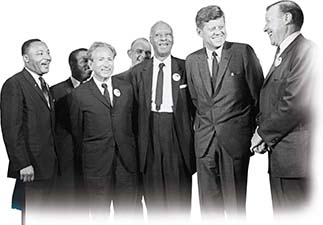SECTION 2: Kennedy’s New Frontier

▲ President Kennedy with prominent civil rights and labor leaders in 1963. Dr. Martin Luther King, Jr., is at the far left.
WITNESS HISTORY  AUDIO
AUDIO
Civil Rights
Although Kennedy did not have a strong civil rights record while in the Senate, he did portray himself as a crusader for African American rights during his campaign. Toward the end of his presidency, he abandoned his cautious approach. In a special report to the American people on civil rights, he talked about the racial inequality that had long endured in the nation:
“It ought to be possible for American students of any color to attend any public institution…. It ought to be possible for American consumers of any color to receive equal service in places of public accommodation … and it ought to be possible for American citizens of any color to register and to vote in a free election…. We preach freedom around the world, and we mean it, and we cherish it here at home, but are we to say to the world and, much more importantly, to each other that this is the land of the free except for the Negroes …?”
—John F. Kennedy, June 11, 1963
Objectives
- Evaluate Kennedy’s domestic policies.
- Assess the impact of the Kennedy assassination.
Terms and People
- New Frontier
- Equal Pay Act
- deficit spending
- space race
- Warren Commission
NoteTaking
Reading Skill: Identify Main Ideas List the characteristics of John F. Kennedy’s style that appealed to the American people.
- Youthful
The Kennedy Image
Why It Matters Kennedy’s determination to change life at home resulted in his domestic agenda called the New Frontier. Faced with a conservative Congress, Kennedy met with opposition as he fought to turn his vision into a reality. Still, he had some success in making changes in Social Security benefits, dealing with poverty and racial discrimination, and spurring new interest and expectations for the space program. Section Focus Question: What were the goals of Kennedy’s New Frontier?
The Kennedy Style
As John Kennedy showed in his 1960 campaign and in his Inaugural Address, he had a special quality—or charisma—that separated him from other politicians. With his exquisitely tailored clothes, quick smile, and sense of humor, he seemed closer to a movie star than to a run-of-the-mill politician. Although he suffered many health problems, he projected youthful health and energy.
He surrounded himself with other distinguished men. Reporters dubbed them “the best and the brightest.” They came from some of the country’s most prestigious businesses and universities. Robert McNamara, president of Ford Motor Company, agreed to serve as Secretary of Defense. Dean Rusk, president of the Rockefeller




